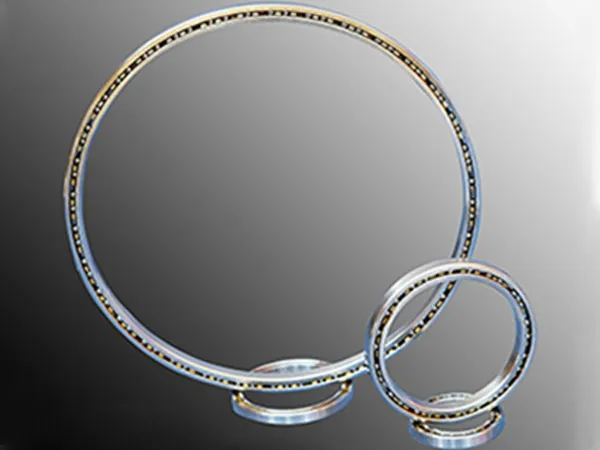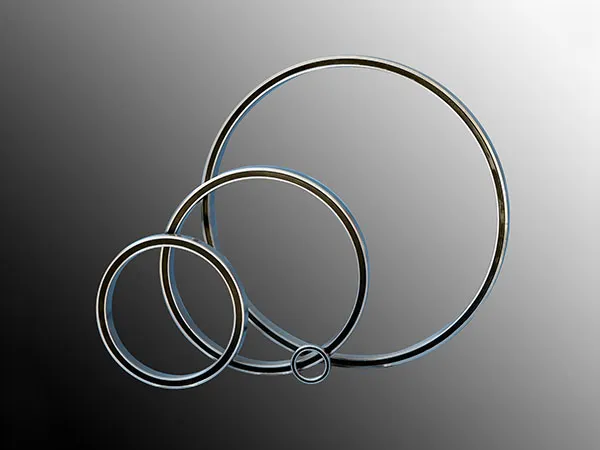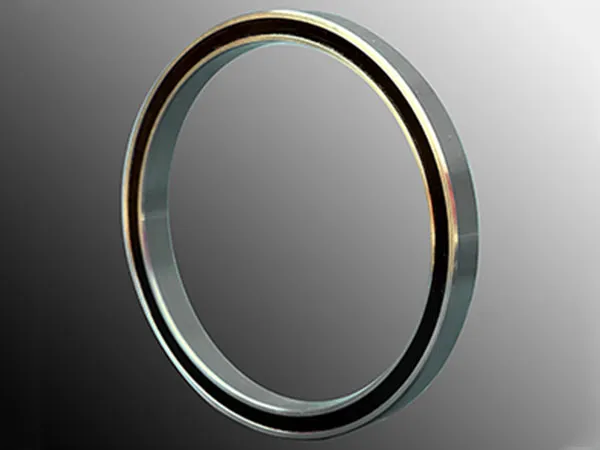The lifespan of thin section bearings, like all bearings, isn't a fixed number of years but is rather determined by a complex interplay of factors, primarily expressed as their "rating life" or L10 life.

This is a standard industry measure. The L10 life is the life in millions of revolutions that 90% of a representative group of identical bearings can be expected to achieve or exceed before material fatigue occurs. The life that 50% of bearings may achieve (L50 or median life) is approximately 5 times the L10 life.
The L10 life can be estimated using a formula:L10=(C/P)p, where:
L10 = basic rating life (millions of revolutions)
C = Dynamic load rating (from the manufacturer's catalog)
P = Equivalent dynamic bearing load (actual load applied)
p = exponent (3 for ball bearings, 10/3 for roller bearings)
f the speed is constant, it's often more practical to calculate the life in operating hours:L10h=(106/(60∗n))∗L10, wheren is the rotational speed in revolutions per minute (r/min).

Load: This is arguably the most critical factor. Higher loads significantly reduce bearing life. It's generally not advisable to apply loads equal to the dynamic load ratings for continuous rotation if a long life is desired.
Speed: Higher rotational speeds can generate more heat and affect lubricant performance, impacting life.
Lubrication: Proper lubrication is paramount.
Type and Viscosity: Choosing the correct lubricant (grease or oil) with appropriate viscosity for the operating conditions is crucial. Too low viscosity leads to insufficient film, while too high causes excessive friction.
Quantity: Adequate grease packing is necessary.
Cleanliness: Contaminants in the lubricant can drastically shorten life.
Maintenance: Regular re-lubrication or oil changes as per manufacturer recommendations are essential.
Contamination: Dust, dirt, moisture, and other foreign particles are major enemies of bearing life. Effective seals or shields are vital to protect the bearing.
Operating Temperature: Extreme temperatures can degrade lubricants and affect bearing material properties. Overheating can lead to premature failure.
Material and Manufacturing Quality: The quality of the bearing steel, its heat treatment, surface finish, and internal geometry all play a significant role. Not all thin section bearings are created equal in this regard.

Mounting and Alignment: Improper installation, misalignment, or uneven support can induce undesirable stresses and reduce life. Thin section bearings are more sensitive to shaft and housing imperfections due to their flexibility.
Application Environment: Factors like vibration, shock loads, and corrosive environments will also impact lifespan.
Reliability Requirements: The L10 life is for 90% reliability. If higher reliability is needed, the calculated life will be shorter.
Design and Stiffness: While thin section bearings offer space and weight savings, their inherent flexibility means the surrounding structure must provide adequate support and stiffness to ensure proper load distribution.
In summary, there's no single answer to "how long do thin section bearings last." Their actual service life is highly dependent on how well the bearing is selected for its specific application, how it's installed, and how diligently it's maintained. Manufacturers like SKF and Kaydon provide tools and detailed information to help engineers calculate the expected life based on these various factors.
How Long Is the Service Life of Slewing Bearings? Key Factors That Determine Durability
2025-12-05 14:26Customized Precision Crossed Roller Bearings: Unlocking Maximum Industrial Performance
2025-11-24 10:45How to Minimize Vibration in Precision Crossed Roller Bearings for Maximum Efficiency
2025-11-19 11:19Top 6 Maintenance Tips for Precision Crossed Roller Bearings to Maximize Lifespan and Accuracy
2025-11-15 13:46Address: Lianmeng Road, Jianxi district, Luoyang City,Henan province.
E-mail: info@lynicebearing.com
Phone: +86-379-60689957
If you are interested in our products and services,
please feel free to contact us!
Get in tuch

+86-379-60689957
Lianmeng Road, Jianxi district, Luoyang City,Henan province.